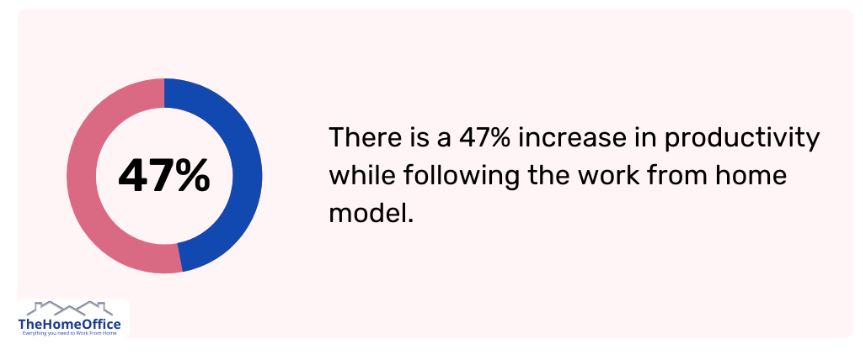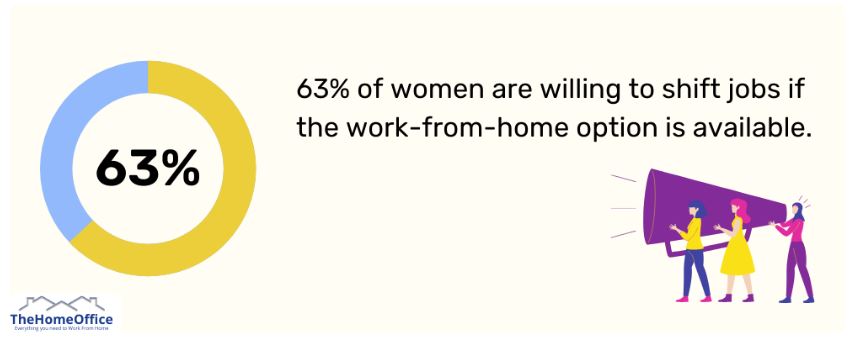9 Interesting Work From Home Statistics In India (2023)
Posted by AUTHOR

Since the global pandemic took over the world, working from home has been the norm. In a bid to keep operations moving and businesses flourishing, companies are doing everything in their captivity to make remote working as feasible as possible.
The work from home model, though it was an initial shock, has turned out to be rather welcoming and beneficial in a number of ways. From improved productivity to efficiency and prolonged health benefits, there are a host of pros to the remote working model.
Here's examining some statistics and trends centered around the work-from-home norm in India.
Important Work From Home Statistics
Here are some of the important statistics and work from home trends to know:
- There is a 47% increase in productivity while following the work from home model.
- 82% of employees prefer working from home.
- 44% of respondents of a Survey, believe that work from home has improved mental health. They've reported longer sleeping hours, better relationships with family members, and time to spend on fitness activities.
- 63% of women are willing to shift jobs if the work-from-home option is available.
- Employee commute accounts for approximately 98% of carbon footprint.
- 71% of employees would forsake a promotion if it meant they could continue working from home.
- More than 95% of all Indian businesses will continue to implement the work from home model.
- 87% of all employees would prefer to work from home.
- 45% of employees would like to adopt a 100% remote work model, while 42% would like more of a hybrid work model.
Note: source of these statistics are added below.
Let’s dive into the statistics one by one.
1. Is Work From Home More Effective?
So, is working from home or the more traditional working from an office more effective in terms of productivity?
A study by India today has concluded that employees working remotely work more times a day and spend less time idling away. There is a 47% increase in productivity while following the work from home model. (Source)
It might appear that work from home, despite being a concept foreign to many of us, has forced us to adapt to this new working model with great aplomb.
2. Do Employees Prefer Work From Home
For some, working from home has been a boon in disguise. While some feel that their social life plummeted due to the remote working model.
But what's the general Sensex on employees' perspective towards working from home?
A survey conducted by Times of India revealed that a whopping 82% of employees prefer working from home. (Source)
It looks like the working from home trend is here to stay for the long run.
3. Does Work From Home Impact Mental Health And Wellbeing?
Most employees have reported that working from home has significantly improved their mental health and wellbeing.
The needless long hours spent on the daily commute and having to shift to other cities have declined due to the work from home model. The majority of employees have shifted to their hometowns owing to the remote working model. Some have even opted for taking up their laptops to vacation spots like hill stations or beaches.
44% of respondents of the YouGov-Mint-CPR Millennial Survey believe that work from home has improved mental health. They've reported longer sleeping hours, better relationships with family members, and time to spend on fitness activities. (Source)
This shift to a more laid-back work trend from the high-pressure environment has significantly helped employees’ mental health.
On the downside, though, working from home has worsened bonds with office colleagues.
4. What Is The Impact Of Work From Home On Women Employees?
While a large number of people are seen to prefer working from home, the case of women might be a bit different. More often than not, women have the extra burden of taking care of the family, child-rearing, and household chores. Even though things are surely changing, the majority of the home-making responsibilities still lie with women.
So, how has the work from home model affected women and their home-work balance?
Indian statistics show that 63% of women are willing to shift jobs if the work-from-home option is available. (Source)
The remote working model post-pandemic has drastically changed the ways in which women view their careers.
This model has enabled a lot of women to surpass family constraints while trying to advance their careers.
On the other hand, a group of women did respond, stating that the work from home model is only feasible with the support of the family. Without a robust support system at home, many women find it better to work in an office away from domestic stress.
5. Impact of Work From Home on The Environment
Studies have it that the working from home model has significantly reduced the stress on the environment. There is a reduction in littering, carbon footprint, and emission of greenhouse gasses.
According to a survey by Sun Microsystems, employee commute accounts for approximately 98% of carbon footprint. (Source)
The U.S. Census reveals that in 2018, the average worker spent an estimated hour commuting per day, which amounted to 225 hours per year. This is at par with spending 9 days in a car — the consequences of which aren't favorable to the environment. (Source)
6. Future Trends In Work From Home
The global pandemic has drastically changed the way we used to work. Even though it has just been two years, it seems like a thing of the past when people used to wake up, get dressed, and commute to an office cubicle. Now it is possible for anyone to work anywhere.
A survey by Forbes magazine states that 87% of all employees would prefer to work from home.
Among these respondents, 45% would like to adopt a 100% remote work model, while 42% would like more of a hybrid work model.
Another interesting statistic is that a whopping 71% of employees would forsake a promotion if it meant they could continue working from home. (Source)
7. Will Work From Home Continue For The Long Run?
Even though the work from home model started as a survival tactic for most businesses due to the pandemic, it looks like most companies are turning it into a permanent model.
More than 95% of all Indian businesses will continue to implement the work from home model. (Source)
The future trends suggest that there will be a steady increase in remote jobs till about 2025.
Many top Indian companies like Nestle, Tata, Infosys, and more are switching to a more flexible hybrid working model.
Final Words
As is evident from the above stats and trends, remote work isn’t going anywhere.
The pandemic may have transformed our lives drastically in the last three years, but it cannot be disputed that it offers a range of advantages to employees and the environment. Employees today would prefer to continue reaping the benefits of declined commute hours, improved flexibility, higher levels of productivity, and better relationships with family members.
We hope this article has provided you with an insight into the current work from home trends and statistics in India.
SHARE:



